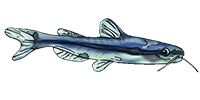I recently bought an L-260 yesterday at a Tropical Fish Auction in Metro-Detroit sponsored by GDAS. The fish was looking well when I wen to bed, when I awoke the L-260 was dead.
As a result these are the options that I thought of:
1) Temperature below 74F in the Church Basement (Auction held here).
2) The poor guy was bagged the day before and we let him free in our tank at 6 pm.
3) The Cat-E-Log states that the nitrates are very bad for this fish.
Can anyone tell me how senstive an L-260 is to nitrite/nitrate exposure?
Now to the information you requested:
Water Quality parameters are as follows:
1) Ammonia next to nil (not detectable by colorimetry.
2) Nitrites next to nil
3) About 25 mg/L Nitrate via colorimetry.
4) pH = 7.1
5) Hardness would be generally soft. It's Detroit City Water! I do not own a GH, or KH kit.
6) Frequency would be 1 to 2 water changes in a 2 week period.
7) Tank Temeperature is about 76F +/-2 F
Tank Setup
1) 46 gallon Bow-front
2) Gravel substrate - brown/black coloration
3) Eheim Ecco Filter (cannister)
4) Heavy driftwood (sinks), heavily planted, some "Cichlid caves for the fish to enjoy (no cichlids reside here!)
5) Tank has been in operation since 2002. 3 months ago we cleaned the gravel, removed the UGFS, and added additional BiroSpiro Bacteria culture.
6) Tankmates include the following: Clown Loaches, killifish, molly, small group of cories, 2 dianema longibarbis (my favorite fish), bluemystis, zebra otos, a lone albino bristlenose pleco, and a clown pleco.
Symptoms
1) L-260 dead in the morning
2) Ambient is about 20 F
[/list][/list]




